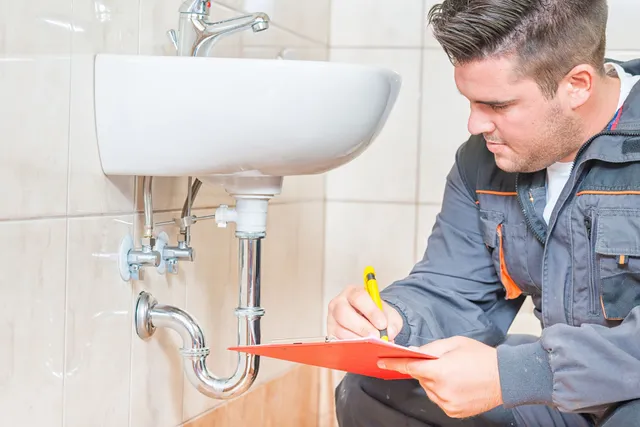Plumbing inspections are crucial for ensuring the safety, efficiency, and proper functioning of a home’s water system. Over time, even minor leaks or unnoticed pipe damage can result in significant water loss, structural damage, and costly repairs. Many homeowners overlook these issues until something goes wrong, such as a burst pipe or a flooded basement. Regular inspections help detect underlying problems early, saving both time and money. We will explore some of the most common issues that arise during plumbing inspections and how homeowners can effectively address them before they escalate into serious complications.
- Leaky Pipes and Hidden Water Damage
One of the most frequent issues uncovered during a plumbing inspection by Veterans Heating and Cooling is a leaky pipe. Even a small, slow drip can lead to significant water waste and hidden structural damage behind walls or under floors. Leaks often result from corrosion, loose fittings, or aging pipe materials. When left untreated, these leaks can cause mold growth and weaken the foundation of your home. The first step in addressing leaks is early detection, which is often achieved through the use of professional inspection tools, such as moisture meters or thermal cameras. Once identified, repairs can involve tightening fittings, replacing worn-out sections, or upgrading to more durable materials such as PEX or copper piping. Homeowners should also monitor their water bills for unexplained increases, as they often indicate hidden leaks. Regular maintenance and pipe insulation in colder climates can further prevent future leaks and keep the system running efficiently.
- Low Water Pressure Throughout the Home
Low water pressure can be frustrating and is another common problem found during plumbing inspections. It typically indicates a clog or buildup within the pipes, a leak in the system, or issues with the main water line. Over time, mineral deposits from hard water can accumulate inside pipes, restricting water flow. In older homes, galvanized pipes may corrode, reducing their internal diameter and exacerbating the pressure problem. To fix this, plumbers often flush the system to clear sediment or use pipe descaling techniques. In severe cases, replacing old pipes may be necessary. Homeowners can also install water softeners to prevent recurring mineral buildup. Monitoring water pressure consistency across different faucets helps pinpoint whether the issue is localized or system-wide. Regular inspections ensure these problems are caught early before they affect water appliances and fixtures.
- Clogged Drains and Sewer Line Blockages
Clogged drains and sewer line blockages are among the most unpleasant yet common findings during plumbing inspections. These issues often stem from the accumulation of grease, soap residue, hair, and even tree roots that invade underground pipes. When ignored, they can cause slow drains, unpleasant odors, or sewage backups that pose health risks. To address these problems, plumbers typically use drain snakes or hydro-jetting equipment to clear obstructions safely and effectively. For long-term prevention, homeowners should avoid disposing of oils, wipes, and non-degradable materials down the drain. Regular professional cleanings can also help maintain smooth flow in both household and main sewer lines. In some cases, video camera inspections are conducted to locate deep blockages or underground pipe collapses. By maintaining good drainage habits and scheduling regular checks, you can prevent costly repairs and keep your plumbing system operating smoothly.
- Faulty Water Heaters and Temperature Fluctuations
Water heaters are another frequent area of concern that is often uncovered during plumbing inspections. Problems such as inconsistent water temperature, rumbling noises, or visible rust around the tank usually indicate sediment buildup or corrosion. A malfunctioning water heater not only affects comfort but also increases energy costs and reduces system efficiency. The solution often depends on the age and condition of the unit. Flushing the tank to remove sediment can improve performance, while older units might require replacement.
Inspectors also check for faulty pressure relief valves, leaks, or improper installation that can lead to safety hazards. For tankless systems, maintenance involves descaling to prevent mineral buildup inside heating elements. Homeowners should schedule annual maintenance to prolong the unit’s lifespan and ensure its safe and reliable operation. A well-maintained water heater provides a steady hot water flow while preventing unexpected breakdowns that can disrupt daily routines.
- Running Toilets and Worn-Out Fixtures
Another frequent issue during plumbing inspections is a running toilet, which can waste hundreds of gallons of water per day. Common causes include a faulty flapper valve, a corroded flush handle, or an improperly adjusted float. Inspectors often detect this issue by listening for constant water movement in the tank or checking for silent leaks using dye tests. Addressing the problem typically involves replacing inexpensive internal components or adjusting water levels to the proper height. Beyond toilets, inspections also reveal leaking faucets, worn-out seals, and outdated fixtures that contribute to water waste.
Replacing older faucets and showerheads with water-efficient models can reduce water consumption and enhance the functionality of your home. Regular fixture inspections also ensure that connections remain tight, preventing small drips from escalating into costly water damage over time. Attention to these details ensures efficient water usage while maintaining a comfortable and reliable plumbing system.
Plumbing inspections play a vital role in home maintenance, helping to uncover hidden issues that could lead to extensive damage and high repair costs. Leaks, clogs, faulty water heaters, or backflow problems are all manageable when identified early and handled properly. Regular inspections and timely maintenance not only extend the life of your plumbing system but also protect your property’s value and ensure its safety. By addressing common issues proactively, homeowners can avoid emergencies and maintain consistent water flow, efficiency, and peace of mind.

